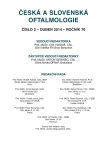Long Term Results of Phakic 6 Refractive Implantation for Myopia Correction
Authors:
Lima Cabrita F. V.; M. Kalfeřtová; M. Burova; V. Veliká; H. Langrová; P. Rozsíval; A. Feuermannová
Authors‘ workplace:
Hradec Králové, přednosta
prof. MUDr. P. Rozsíval, CSc., FEBO
; Oční klinika FN a LFUK
Published in:
Čes. a slov. Oftal., 70, 2014, No. 2, p. 56-58
Category:
Original Article
Overview
Objective:
To evaluate the safety and the long term results of anterior chamber phakic lens, Phakic 6 Refractive, for myopia correction.
Methods:
In this retrospective study we reviewed the charts of 35 myopic patients (62 eyes) who had implantation of anterior chamber phakic lenses (Phakic 6 Refractive, Ophthalmic Innovations International, California, USA) for correction of myopia. The mean age of patients was 26 years (18 to 45 years). The mean spherical refraction was -9.9 (-4 to -18 D). The best corrected distant visual acuity (BCDVA) was 0.92 (1.2 to 0.3) before surgery. The mean follow-up was 8 years (4 to 10). The mean endothelial cell count was 2481 cells/mm2 and the mean pachymetry was 540 μm before surgery. In those patients who needed a second surgical intervention (explantation or lens reposition) the last follow-up visit is the visit before the lens explantation or reposition. The same surgeon (P. R.) performed all surgeries and used the same technique in each surgery.
Results:
On the final follow up visit the BCDVA was in the mean 1.02 (1.5 to 0.5). The spherical refraction was in the mean – 0.53 D (-3.0 to +1.0). We noticed a 16% decrease in the mean number of corneal endothelial cells, and no change in the pachymetry values. We had to explant the lenses in 7 eyes (12 %) because of the decreased endothelial cells count. 2 eyes (3.0 %, 1 patient) had to receive treatment for glaucoma, 4 eyes (6.5 %) had to have the artificial lens repositioned, 1 patient had to have photocoagulation therapy for a retinal tear. 93 % of the study eyes had stable refraction during the study period. There was a 10 % increase in the average BCDVA, and there was a 95 % improvement of the original refractive error.
Conclusions:
In selected cases, the implantation of Phakic 6 Refractive anterior chamber lens is a viable option despite it is currently largely abandoned.
Key words:
Phakic 6 Refractive implantation, myopia correction
Sources
1. Alió JL, Abdelrahman AM, Javaloy J, Iradier MT, OrtuĖo V.: Angle-supported anterior chamber phakic intraocular lens explantation causes and outcome. Ophthalmology,113; 2006 : 2213–2220.
2. Applegate RA, Howland HC.: Refractive surgery, optical aberrations, and visual performance. J Refract Surg, 13, 1997, 295–299.
3. Applegate RA, Howland HC.: Refractive surgery, optical aberrations, and visual performance. J Refract Surg, 13; 1997 : 295–299.
4. Baikoff G, Arne JL, Bokobza Y, et al.: Angle-fixated anterior chamber phakic intraocular lens for myopia of -7 to -19 diopters. J Refract Surg, 4; 1998 : 282–293.
5. Barraquer J.: Plastic lenses in the anterior chamber; indications; technic, personal experience with 100 cases. Bull Soc Belge Ophthalmol, 144; 1957 : 503–516.
Labels
OphthalmologyArticle was published in
Czech and Slovak Ophthalmology

2014 Issue 2
Most read in this issue
- Extraocular Muscle Involvement in Patients with Thyroid-associated Orbitopathy
- Retinopathy of Prematurity. Part I
- Acute Posterior Multifocal Placoid Pigment Epitheliopathy – Case Report
- Retinopathy of Prematurity – Therapy. Part 2
